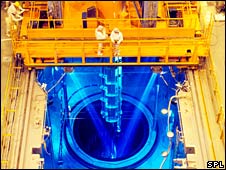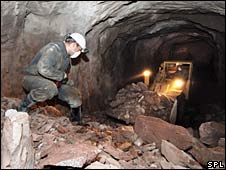
Fuel rods being loaded into a nuclear power station's reactor core
(SPL)
Some anticipate a major expansion of nuclear
power
The case for nuclear power as a low carbon
energy source to replace fossil fuels has been challenged in a new report
by Australian academics.
It suggests greenhouse emissions from the
mining of uranium - on which nuclear power relies - are on the rise.
Availability of high-grade uranium ore is
set to decline with time, it says, making the fuel less environmentally
friendly and more costly to extract.
The findings appear in the journal Environmental
Science & Technology.
Yes, we can probably find new uranium
deposits, but to me that's not the real issue (Dr Gavin Mudd, Monash
University)
A significant proportion of greenhouse emissions
from nuclear power stem from the fuel supply stage, which includes uranium
mining, milling, enrichment and fuel manufacturing.
Others sources of carbon include construction
of the plant - including the manufacturing of steel and concrete materials
- and decomissioning.
The authors based their analysis on historical
records, contemporary financial and technical reports, and analyses of
CO2 emissions.
Experts say it is the first such report to
draw together such detailed information on the environmental costs incurred
at this point in the nuclear energy chain.
Nuclear impact
The report is likely to come under close scrutiny
at a time when governments around the world are considering the nuclear
option to meet future energy demands and reduce greenhouse gas emissions.

Uranium mining in Siberia (SPL)
Mining companies are likely to have to dig deeper for deposits
|
suite:
Lead author Gavin Mudd, from Monash University
in Australia, told BBC News: "Yes, we can probably find new uranium
deposits, but to me that's not the real issue. The real issue is: 'what
are the environmental and sustainability costs?'
New uranium deposits are likely to be deeper
underground and therefore more difficult to extract than at currently exploited
sites, said Dr Mudd.
In addition, he said, the average grade of
uranium ore - a measure of its uranium oxide content and a key economic
factor in mining - is likely to fall. Getting uranium from lower-quality
deposits involves digging up and refining more ore.
Even in the worst case scenario for
CO2 emissions, the impact of nuclear on greenhouse emissions
is still very small (Thierry Dujardin, NEA)
Transporting a greater amount of ore will
in turn require more diesel-powered vehicles - a principal source of greenhouse
emissions in uranium mining.
"The rate at which [the average grade of
uranium ore] goes down depends on demand, technology, exploration and other
factors. But, especially if there is going to be a nuclear resurgence,
it will go down and that will entail a higher CO2 cost,"
Dr Mudd explained.
Overall, the report suggests that uranium
mining could require more energy and water in future, releasing greenhouse
gases in greater quantities.
New technology
Thierry Dujardin, deputy director for science
and development at the Nuclear Energy Agency (NEA), said the analysis made
an important contribution to clarifying the impact of nuclear energy on
CO2 emissions.
"It is the beginning of the answer to a
question I have raised in many fora, including within the agency,"
he told BBC News.
But Mr Dujardin said he did not fully agree
with the authors' conclusions.
"Even in the worst case scenario for
CO2 emissions, the impact of nuclear on greenhouse emissions
is still very small compared with fossil fuels," he explained.
The NEA official admitted that lower grades
of ore might have to be exploited in future, but he added that emissions
from mining were only a small part of those produced in the nuclear supply
chain as a whole.
He said he was also confident that entirely
new deposits would be found as the industry stepped up its exploration
effort.
The nuclear industry is carrying out research
into recovering uranium from rocks used in the industrial production of
phosphates. Various technologies based on solvent extraction can be used
to get the element from phosphate rocks.
And in the longer term, some predict that
so-called fast breeder reactor technology would increase by up to 50-fold
the amount of energy extracted from uranium.
Paul.Rincon-INTERNET@bbc.co.uk
Voir:
http://pubs.acs.org/journals/esthag/
http://pubs3.acs.org/acs/journals/toc.page?incoden=esthag |

